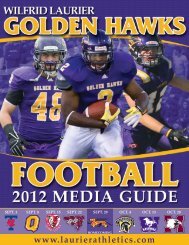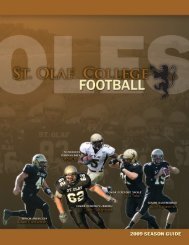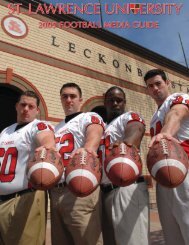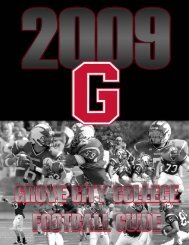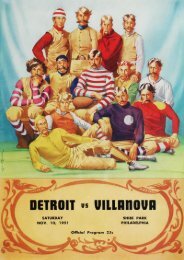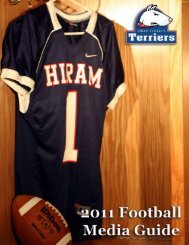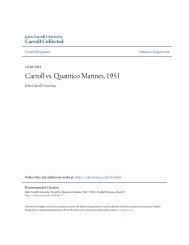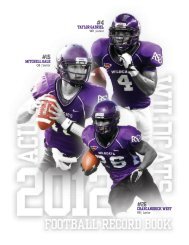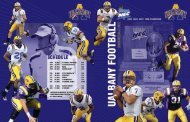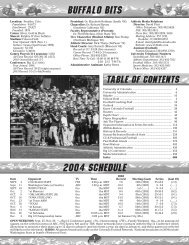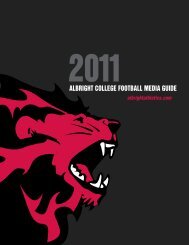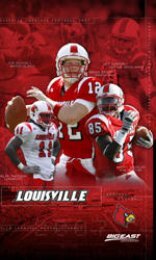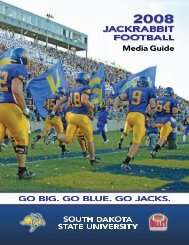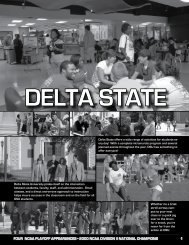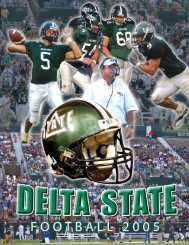Player Profiles - of College Football Games
Player Profiles - of College Football Games
Player Profiles - of College Football Games
Create successful ePaper yourself
Turn your PDF publications into a flip-book with our unique Google optimized e-Paper software.
104<br />
Grand Valley State was one <strong>of</strong> only a handful <strong>of</strong> colleges and universities<br />
which began playing football in the 1970’s. According to<br />
NCAA records, the Lakers have been one <strong>of</strong> the most successful <strong>of</strong><br />
all collegiate squads to take the field during that time period.<br />
Laker football has been a key element <strong>of</strong> Grand Valley’s rise from<br />
a small college to a regional university. President Arend D. Lubbers<br />
began the push for a team when he arrived in 1969. A year later, a<br />
Laker junior varsity team took the field. Then, in the fall <strong>of</strong> 1971, the<br />
Lakers kicked <strong>of</strong>f their first varsity season. “It was clear that Grand<br />
Valley was changing from a commuter college, to a residential school<br />
in need <strong>of</strong> activities such as music, drama, and athletics,” Lubbers<br />
recalled. “<strong>Football</strong> gave us the anchor, something you could build<br />
your weekend around.”<br />
The Origin <strong>of</strong> the Program<br />
Lubbers came to Grand Valley<br />
from Central <strong>College</strong> in Pella,<br />
Iowa, which had a successful<br />
football tradition. He hired<br />
Zeeland native Ron Schipper,<br />
who had been at Central for 33<br />
years, played in three national<br />
finals, and won one national<br />
championship.<br />
“I was used to success at<br />
Central <strong>College</strong>, so when we<br />
started at Grand Valley, I wanted<br />
to have a successful program<br />
instead <strong>of</strong> throwing the ball out<br />
and saying, ‘O.K. boys, it doesn’t<br />
matter whether we win or<br />
not.’”<br />
But despite Lubbers’ success<br />
at Central <strong>College</strong>, it took almost<br />
nine years before Grand Valley<br />
had the total package.<br />
The First Varsity Team<br />
With blessing from the Board<br />
<strong>of</strong> Control, GV launched its football<br />
program to play a junior varsity<br />
schedule in 1970 and<br />
became varsity in 1971. On<br />
March 24, 1970, Lubbers, along<br />
with athletic director Charles H.<br />
Irwin, announced the hiring <strong>of</strong><br />
Robert “Rip” Collins, a successful high school coach at Grand<br />
Rapids Ottawa Hills. Success didn’t come quickly for the Lakers, and<br />
it took almost three years to win a football game. Collins was unable<br />
to get the program <strong>of</strong>f to a successful start after going 0-13 and being<br />
outscored 534-58 in 1971 and 1972.<br />
Harkema Begins the Tradition<br />
E. James Harkema took over as head coach in January <strong>of</strong> 1973,<br />
coming to GV from Northern Illinois where he was an <strong>of</strong>fensive<br />
backfield coach.<br />
Also awaiting Harkema was a brand new football field constructed<br />
in 1972 which featured the first “prescription athletic turf” (PAT)<br />
football playing surface in the country.<br />
It was ironic that Harkema opened the 1973 campaign against his<br />
alma mater Kalamazoo <strong>College</strong>, where he won 10 varsity letters and<br />
led the Hornets to six MIAA championships.<br />
John Mahan rushed 26 times for 158 yards and Steve Brems added<br />
122 more to lead GV to its first football victory in its season opener<br />
at home, a 27-14 win over Kalamazoo. Defensive tackle Bryce Berth<br />
and <strong>of</strong>fensive guard Tom Tefft were named the <strong>of</strong>fensive and defensive<br />
players <strong>of</strong> the game.<br />
To prove it was not fluke, the Lakers did it again the following<br />
Running back John Mahan<br />
2007 Laker <strong>Football</strong> Media Guide<br />
Storied Tradition<br />
week with Mahan rushing for 147 yards and Brems adding 138 as<br />
GV defeated Chicago Circle 40-8 in a night game played at Soldier<br />
Field in Chicago.<br />
Grand Valley outscored opponents 259-120 and posted their first<br />
winning season. 1973 marked the start <strong>of</strong> the great football tradition<br />
at Grand Valley, and during the next 10 years under Harkema they<br />
would post a 68-29-1 record, win three Great Lakes Conference football<br />
championships and make one trip to the NAIA play<strong>of</strong>fs.<br />
Also during that period, a number <strong>of</strong> Lakers would begin careers<br />
in pr<strong>of</strong>essional football. Jim Schaap and Tom Tefft, 1971-73, were<br />
the first Lakers to sign pr<strong>of</strong>essional football contracts when they<br />
signed with the Detroit Wheels <strong>of</strong> the World <strong>Football</strong> League in 1974,<br />
setting the stage for a number <strong>of</strong> GV football alums to follow into the<br />
National <strong>Football</strong> League during<br />
that period. They include Gary<br />
Evans 1975-77 (New York Jets),<br />
Ron Essink 1976-79 (Seattle<br />
Seahawks), Ron Rubick 1978-81<br />
(Detroit Lions), Steve Michuta<br />
1979-81 (Cleveland Browns),<br />
and Jeff Chadwick 1980-82<br />
(Detroit Lions).<br />
Many Laker followers feel<br />
that the 1975 team, with a 7-2-1<br />
record, may have set the standards<br />
for many years to come.<br />
After dropping a hard fought 15-<br />
6 contest to Wayne State, which<br />
also included the loss <strong>of</strong> their<br />
quarterback Scott VanDyken for<br />
the season, the Lakers bounced<br />
back to shutout Ferris State, 38-<br />
0, for their first win over the<br />
Bulldogs, defeat Saginaw Valley<br />
and Hillsdale, tie Northwood,<br />
and lose on a trick play to<br />
Northern Michigan, 21-17.<br />
1976 was the year Grand<br />
Valley would receive national<br />
attention in more ways than one.<br />
It all started at Michigan Tech<br />
when Roger McCoy was credited<br />
with a 39-yard field goal<br />
although the ball never cleared<br />
the crossbar. Instead, the ball hit<br />
a public address wire some 50<br />
feet in the air and the ball dropped straight down in front <strong>of</strong> the goal<br />
posts.<br />
A lengthy deliberation following was dominated by Michigan Tech<br />
coach Jim Kapp, who brought the ground rule to the attention <strong>of</strong> the<br />
<strong>of</strong>ficials, that if that ball should hit the wire in flight, the down should<br />
be replayed. Kapp’s appeal was denied on the basis that he forgot to<br />
tell Grand Valley or the <strong>of</strong>ficials before the start <strong>of</strong> the game that the<br />
rule existed, and because the field goal was allowed, the Lakers<br />
walked away with a 10-8 victory. McCoy had set a GVSU record<br />
with a 60-yard field goal the previous week against Grand Rapids JC<br />
at Houseman Field.<br />
The Lakers get on the Map<br />
The game which put Grand Valley on the map was the season<br />
finale against Northern Michigan. The Wildcats came into Allendale<br />
as defending champions, boasting an 18-game winning streak,<br />
ranked No. 1 in Division II and fresh <strong>of</strong>f an 82-7 whipping <strong>of</strong><br />
Nebraska-Omaha.<br />
ABC television sent a crew to feature Northern Michigan, but it<br />
was the Lakers, playing 21 seniors who built up a 24-0 lead and went<br />
on to shock the Wildcats 31-14 before the then largest crowd in GV<br />
history at the time.



